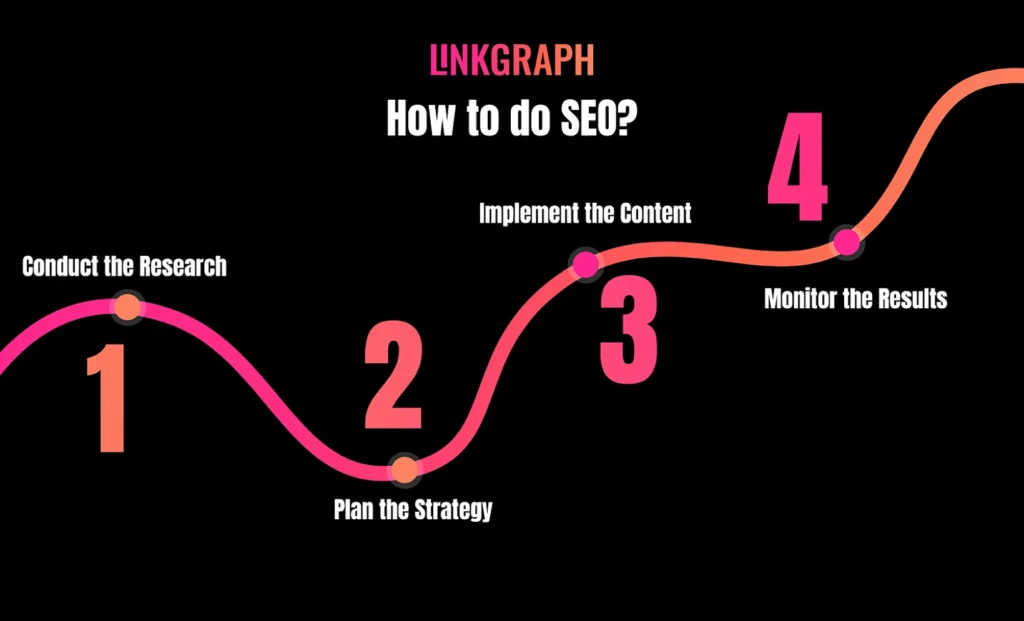What is SEO (Search Engine Optimization) and How to Do It?
SEO (Search Engine Optimization) improves the visibility of a website in search engine results pages to attract more organic traffic. SEO helps search engines understand content by […]
SEO (Search Engine Optimization) improves the visibility of a website in search engine results pages to attract more organic traffic. SEO helps search engines understand content by optimizing structure, keywords, and authority signals. SEO supports businesses in reaching people actively searching for services, products, or information online.
SEO has four main pillars that support better rankings and user experience, which are Technical SEO, On-page SEO, SEO Content, and Off-page SEO. SEO builds trust and visibility through clear content, fast performance, mobile access, and quality backlinks. SEO increases traffic over time without relying on paid advertising.
This article explains how to do SEO by researching keywords, planning a strategy, publishing content, and tracking progress. SEO includes audits, pricing, services, and guidance for beginners and professionals. SEO also covers newer methods like AI SEO and GEO to improve visibility in AI-generated answers.
What is SEO (Search Engine Optimization)?
SEO is the practice of improving website visibility in search engine results pages (SERPs). SEO helps to optimize website content, structure, and authority to attract more unpaid organic traffic. What does SEO stand for? The acronym SEO stands for Search Engine Optimization, which means making strategic changes to a website so that search engines recognize its relevance and authority for specific queries. Put simply, SEO is a process designed to help websites appear higher in organic, non-paid search listings.
SEO is a continuous, layered process. SEO includes refining technical elements like site structure, speed, and mobile-friendliness, as well as on-page elements like content, keywords, and metadata. Off-page factors like backlinks also play a role. These ongoing SEO activities help search engines crawl, understand, and rank the site more effectively.
SEO improves website relevance, authority, and usability in search engines, which increases its organic traffic. So, what is SEO in digital marketing? In digital marketing, SEO serves as an essential discipline that ensures websites remain discoverable to people searching for specific products, services, or information. Strong SEO supports business growth by maintaining consistent visibility in search engines without relying on paid ads.
Why is SEO important?
SEO is important because it drives valuable organic traffic to a website by improving its rankings for relevant search queries. Higher visibility in search engines through SEO helps reach people who are already looking for the products, services, or information the website provides. SEO directly contributes to increased leads and sales through websites. On the internet, this organic exposure by SEO is a vital part of any successful internet marketing strategy.
There are three main reasons why SEO matters. Firstly, SEO generates traffic by helping websites rank for terms the target audience searches. Secondly, SEO is cost-effective, allowing companies to attract visitors over the long term without incurring ongoing ad costs. Thirdly, SEO increases brand awareness, as appearing prominently in search results helps establish authority and build recognition. Effective SEO optimization enables companies to position their websites as credible resources, earn customer trust, and gain a sustainable competitive edge in search results.
What are the 4 Pillars of SEO?
SEO has 4 main pillars, each one supporting the overall health and performance of a website. Together, the 4 pillars of SEO help search engines discover, understand, and rank content effectively. Mastering all 4 pillars of SEO ensures a well-rounded strategy that improves visibility, drives targeted traffic, and keeps a brand competitive in search.
The 4 pillars of SEO are Technical SEO, On-page SEO, SEO Content, and Off-page SEO. The 4 pillars of SEO are listed below.
1. Technical SEO
Technical SEO refers to optimizing the backend and infrastructure of a website to ensure search engines easily crawl, index, and understand its content. Technical SEO focuses on the technical aspects rather than the visible content on the site.
Key features of technical SEO include improving site speed, ensuring mobile-friendliness, implementing HTTPS security, fixing crawl errors, and creating XML sitemaps. Optimizing site architecture for better navigation and indexing is also important for technical SEO.
Technical SEO is important because it forms the foundation of website performance in search results. Without a solid Technical SEO setup, search engines struggle to access pages or interpret content properly. This prevents a website from ranking well even if the content is high quality.
2. On-page SEO
On-page SEO is the practice of optimizing individual web pages to improve their relevance and usability for specific search queries. On-page SEO involves both the content and the HTML source code of a page.
Features of On-page SEO include crafting effective meta titles and descriptions and using appropriate header tags. On-page SEO also involves optimizing keyword placement and density and creating clean URL structures. Finally, On-page SEO ensures internal links guide both users and search engines through the website effectively.
The importance of on-page SEO lies in its ability to clearly communicate to search engines what each page is about and how it satisfies user intent. Proper on-page SEO optimization makes pages more discoverable and relevant, increasing the chances they will rank higher in search results.
3. SEO Content
SEO content refers to original, valuable, and targeted material created to meet the needs and interests of a defined audience while including relevant keywords. It aims to align with search intent and provide answers to specific queries that users enter into search engines.
Features of SEO content include well-researched blog posts, articles, videos, and other formats that provide clear, useful information. It also involves natural keyword integration, strong internal linking, clear structure, and content that satisfies both search engine requirements and user expectations without keyword stuffing.
SEO content plays an important role in improving organic visibility. It attracts and retains visitors, signals authority and trust to search engines, and helps earn backlinks. High-quality SEO content contributes to higher rankings, increased traffic, and stronger overall search performance over time.
4. Off-page SEO
Off-page SEO includes all the activities performed outside of a website that influence its reputation and authority in the eyes of search engines. These efforts help shape how trustworthy and relevant a site appears based on external signals.
Key features of Off-page SEO include acquiring backlinks from reputable websites, participating in guest blogging, running digital PR campaigns, conducting influencer outreach, engaging on social media, and earning brand mentions or citations from credible sources.
Off-page SEO is important because search engines treat external references as endorsements of site value. A strong off-page SEO profile increases domain authority, improves rankings in search results, and expands brand visibility across the web.

How to do SEO?
Improving website visibility and growing organic traffic requires understanding how to do SEO. Learning how to do SEO involves research, planning, execution, and continuous optimization. Following proven SEO methods and applying helpful recommendations allows content to match search intent, ensures the site is optimized for search engines, and supports long-term authority building.
There are 4 key steps to doing SEO. The 4 key steps to doing SEO are listed below.
1. Conduct the Research
Conducting research is the first and most important step of doing SEO because it sets the foundation for every part of the strategy. Without identifying what the audience is searching for, who the competitors are, and which topics offer the most opportunity, optimization efforts lack focus and direction.
Conducting research in SEO involves identifying the most relevant keywords, topics, and trends related to the business so that content and optimization tactics align with real-world search behavior. It also includes analyzing competitor websites to understand their strengths and find areas where there is an opportunity to perform better.
Thorough research is important because it targets terms and phrases that potential customers actually use, bringing in qualified organic traffic. It also provides insight into the level of competition, allowing for the development of content and strategies with a higher likelihood of ranking successfully.
There are many best practices for conducting research for SEO. The best practices for conducting research for SEO are listed below.
- Use keyword research tools to identify short-tail and long-tail keywords.
- Analyze top-ranking pages and competitor websites to discover content gaps and additional keyword opportunities.
- Group related keywords into thematic clusters to plan content around closely related topics.
- Check search volume and difficulty scores to identify terms with strong traffic potential and achievable competition.
- Review seasonal trends and search behavior using tools like Google Trends to plan for fluctuating interest and new topic ideas.
- Study search intent behind the queries you research to make sure the content you produce matches what searchers want.
2. Plan the Strategy
Planning the strategy in SEO means deciding which pages to optimize, which new content to create, and what off-page tactics to pursue. It also involves setting measurable goals such as improving rankings for specific keywords, increasing organic traffic, or earning backlinks.
This step is important because it brings structure to the SEO process. Without a strategy, efforts become scattered without a unified purpose or clear milestones. Creating a plan ensures every change supports larger business goals.
There are many best practices for planning the strategy for SEO. The best practices for planning the strategy for SEO are listed below.
- Develop a prioritized list of target keywords and align them with existing and new content opportunities.
- Create a content calendar to schedule what content you’ll produce and when, ensuring consistency over time.
- Map your keywords to specific pages or future content so you avoid duplicate targeting and improve relevance.
- Set measurable KPIs such as ranking improvements, organic traffic growth, and backlink goals to track progress.
- Balance short-term wins (like quick on-page fixes) with long-term goals (such as authority building and ongoing link acquisition).
- Include technical, on-page, and off-page optimization in your plan so all aspects of your site improve together.
3. Implement the Content
Planning the strategy in SEO means deciding which pages to optimize, which new content to create, and what off-page tactics to pursue. It also involves setting measurable goals such as improving rankings for specific keywords, increasing organic traffic, or earning backlinks.
This step is important because it brings structure to the SEO process. Without a strategy, efforts become scattered without a unified purpose or clear milestones. Creating a plan ensures every change supports larger business goals.
There are many best practices for implementing the content for SEO. The best practices for implementing the content for SEO are listed below.
- Write content that matches user intent and thoroughly covers the topic, answering the questions searchers have.
- Use target keywords naturally in titles, headings, and throughout the body of the text without keyword stuffing.
- Optimize images with descriptive file names, alt text, and proper compression to improve accessibility and page speed.
- Structure your content with clear headings, bullet points, and short paragraphs to enhance readability.
- Include relevant internal links to other pages on your site and external links to credible, authoritative sources.
- Review and edit your content for quality, ensuring it’s accurate, up to date, and valuable to your target audience.
4. Monitor the Results
Monitoring the results in SEO means tracking progress and analyzing data to evaluate how optimizations and content perform. It includes reviewing rankings, traffic, conversions, and user behavior to determine what works effectively and what needs adjustment.
This step is important because it measures the impact of SEO efforts and supports data-driven decision-making. Without regular monitoring, it becomes difficult to identify which strategies deliver results and which require further refinement, limiting long-term visibility improvements.
There are many best practices for monitoring the results for SEO. The best practices for monitoring the results for SEO are listed below.
- Use tools like Google Analytics and Google Search Console to track key metrics such as organic traffic, impressions, click-through rates, and keyword rankings.
- Set up goals and conversions to measure the business value of your organic search traffic, such as lead submissions, purchases, or signups.
- Review the technical health of the site regularly with site auditor tools to identify and resolve issues promptly.
- Monitor competitor rankings and strategies to discover new opportunities or emerging trends to use.
- Run regular performance audits to evaluate the success of your SEO efforts and refine your strategy based on data.
- Adjust content and optimization tactics as needed to improve underperforming pages and maintain steady progress toward your goals.
Can you do SEO by Yourself?
Yes, SEO can be done independently. Even though SEO seems complex at first, it becomes achievable by following a proven SEO template and taking one step at a time. The key to doing SEO independently is starting with the basics, maintaining consistency, and using the right tools and processes to stay organized.
There are many steps to follow in an SEO checklist to do SEO independently. The steps to follow in an SEO checklist to do SEO independently are listed below.
- Conduct keyword research to identify terms your audience is searching for.
- Optimize titles, headings, and meta descriptions on each page.
- Improve website technical health by enhancing site speed, mobile-friendliness, and structure.
- Create valuable, original content that matches search intent.
- Earn backlinks by sharing content and reaching out to reputable websites.
- Monitor your progress using tools like Google Analytics and Search Console.
DIY SEO is practical because it’s a continuous process that rewards persistence. Many people begin by learning the basics and gradually see measurable results on their own websites. Over time, confidence and expertise grow by following a structured plan and adapting strategies to improve rankings and drive more organic traffic.
How Long does SEO Take to Show Results?
SEO typically takes around three to six months to show measurable results for most websites. Search engines need time to crawl and index pages and evaluate signals like backlinks, on-page optimization, and user behavior before adjusting rankings. Established websites in moderately competitive industries often see improvements within this timeframe when content and structure are properly optimized.
So, how long does local SEO take? Local SEO results typically appear faster, usually within three to six months. For businesses in less competitive local areas, listing in directories, earning citations, and generating positive reviews help improve visibility more quickly due to lower competition.
For those asking how long does SEO take to work for new websites? SEO generally takes six to nine months or more because new domains need time to gain authority and trust. Following key steps such as conducting research, planning the strategy, implementing the content, and monitoring the results helps accelerate progress. Using a solid SEO checklist and template ensures that all efforts remain focused and consistent, allowing momentum to build faster and supporting long-term organic success.
What is an SEO Audit?
An SEO audit is a comprehensive evaluation of website technical setup, on-page elements, and off-page profile to identify issues that affect search engine rankings. SEO audit examines factors like site speed, mobile usability, indexation, content relevance, and backlink quality to pinpoint areas needing improvement.
Central to this process is a detailed seo analysis that uncovers problems and opportunities, providing a clear plan to enhance search engine compatibility and ensure the site complies with ranking standards. An SEO audit lays the foundation for sustained organic growth and improved visibility.
With a clear understanding of SEO audits, it’s important to know who manages these efforts. The next section explains the role of an SEO specialist.
What is an SEO Specialist?
An SEO specialist is a professional who improves website search engine rankings through technical optimization, content strategy, and performance analysis. Also known as an SEO consultant, SEO expert, SEO professional, or SEO manager, the role of an SEO specialist involves assessing site strengths and weaknesses and implementing best practices to increase organic visibility.
Business goals and available resources determine when an SEO specialist is needed. An SEO specialist provides expert guidance on SEO management by helping navigate algorithm changes, optimize content, and build authority. An SEO specialist often works within or leads an SEO team, coordinating efforts across content creators, developers, and marketers to maintain a cohesive and effective SEO strategy.
What is an SEO Agency?
An SEO agency is a company that provides specialized services to help businesses improve their visibility and rankings in search engines. Sometimes called an seo company or an seo firm, an SEO agency typically employs a team of professionals who cover all aspects of SEO, including research, technical optimization, content creation, link building, and ongoing strategy.
Choosing an SEO agency involves following a few key steps. Firstly, review the proven track record and client case studies of the SEO agency to verify expertise. Secondly, check for transparent pricing and clear reporting to understand exactly what will be delivered. Thirdly, focus on SEO agencies that take the time to understand business goals and customize strategies to the industry, such as LinkGraph, an award-winning SEO company for SEO services known for data-driven approaches and measurable results.
What is Link Graph?
LinkGraph is an seo agency that specializes in helping businesses grow their organic search visibility through a data-driven and holistic approach. Known for its award-winning team, LinkGraph offers a full suite of SEO services. These LinkGraph SEO services include advanced technical optimization, AI-powered keyword research, on-page and off-page strategy, high-authority link building, and content development.
LinkGraph is also recognized for proprietary software tools like SearchAtlas, which help clients identify high-impact opportunities and track performance with clear, actionable metrics. Expertise and personalized campaigns make LinkGraph a top choice for companies aiming to scale SEO and achieve measurable, long-term growth.
What are SEO Services?
SEO services are strategies and techniques that help websites improve their rankings in search engine results. These SEO services typically include on-page optimization (such as improving content and metadata), technical enhancements (such as boosting site speed and mobile usability), and off-page activities (such as earning links from trusted sites).
The goal of SEO services is to make a website more accessible to search engines, increase its organic traffic, and connect the business with the right audience over the long term.
How Much Does SEO Cost?
SEO pricing typically ranges from an average of $1,000 to $2,500 per month, depending on project scope, provider expertise, and industry competitiveness. Smaller businesses find affordable SEO options starting around $500 per month, while larger companies and competitive industries often require $2,500 to $5,000 or more monthly to achieve lasting results.
Hourly rates for SEO professionals usually range between $50 and $150 per hour. Agencies may also offer project-based packages for one-time audits or content campaigns, costing anywhere from $1,000 to $10,000 or more depending on website size and complexity. SEO pricing varies widely based on factors like target keywords, technical challenges, and desired outcomes. Aligning investment with realistic goals and timelines maximizes value and ROI.
How Long Does it Take to Learn SEO?
Learning SEO typically takes one to three months to understand core SEO terms and basic concepts by studying an SEO tutorial or enrolling in a beginner course. More practical expertise develops over six to twelve months through regular practice and hands-on work with websites and tools, which helps strengthen understanding of SEO strategies and measure their effectiveness. Mastering SEO is an ongoing process since search engines frequently update algorithms, requiring continuous learning and years of experience to stay current.
How does SEO change over time?
SEO has evolved as search engines have refined their algorithms to focus on delivering the most relevant, user-friendly results. In its early days, SEO relied heavily on keyword stuffing and link-building tactics. Major updates like Google Panda and Penguin changed the game by penalizing these manipulative practices and prioritizing high-quality, informative content.
With the rise of mobile-first indexing, local search, and AI-driven algorithms like RankBrain, search engines now reward websites that offer great user experiences and match search intent. Modern SEO emphasizes creating valuable content, earning credible backlinks, and maintaining technical health, all supported by SEO statistics that highlight how rankings are influenced by usability, authority, and relevance.
To keep up, marketers use SEO forecasting tools to anticipate trends and improve long-term strategies. Many stay updated by attending SEO conferences or joining SEO workshops, where they learn about the latest algorithm updates and industry best practices. Popular sources like Moz, Search Engine Journal, and Neil Patel help professionals adapt to changes in search.
What are the alternatives to SEO?
While SEO remains a core strategy for long-term organic growth, other digital marketing methods drive traffic and increase visibility more immediately. These alternatives complement or, in some cases, substitute for SEO depending on business goals, timeline, and resources.
The 3 alternatives to SEO are SEM, PPC, and GEO. The 3 alternatives to SEO are listed below.
- SEM (Search Engine Marketing): A broader digital strategy that uses paid search ads to generate quick visibility in search engines.
- PPC (Pay-per-click): A specific form of paid advertising where businesses pay each time a user clicks on their ad.
- GEO (Generative Engine Optimization): An emerging strategy that focuses on optimizing content for inclusion in AI-generated responses from tools like ChatGPT, Perplexity, and Google AI Overviews.
SEO vs. SEM
SEM (Search Engine Marketing) is a digital marketing strategy that involves paying for ads to appear in search engine results. It includes platforms like Google Ads, where businesses bid on keywords to display their ads at the top of the SERPs.
The difference between SEO and SEM is how traffic is earned. SEO focuses on improving organic rankings through content, technical improvements, and backlinks. SEM relies on paid placements for immediate visibility.
There are many differences between SEO and SEM. The differences between SEO and SEM are listed below.
- Traffic Source: SEO earns traffic organically; SEM pays for placement.
- Cost Structure: SEO requires time and resources; SEM charges per click or impression.
- Speed: SEO takes longer to show results; SEM delivers immediate visibility.
SEO vs. PPC
PPC (Pay-per-click) is a form of digital advertising where businesses pay each time a user clicks on their ad. It’s a component of SEM and is commonly used for platforms like Google Ads and Bing Ads.
The difference between SEO and PPC is in the cost and longevity. SEO builds long-term visibility without direct costs per visitor, while PPC generates instant traffic but stops when the budget runs out.
There are many differences between SEO and PPC. The differences between SEO and PPC are listed below.
- Payment Model: SEO is free per click; PPC charges for every click.
- Longevity: SEO delivers ongoing results; PPC stops when the campaign ends.
- Click Behavior: Users often trust organic listings more than paid ads, impacting CTR.
SEO vs. GEO
GEO (Generative Engine Optimization) is a new strategy that focuses on optimizing content for visibility in AI-generated answers. For those asking what is GEO, it refers to the practice of creating content designed to be cited by large language models like ChatGPT, Google AI Overviews, and Perplexity, rather than ranked in traditional search engine results.
The difference between SEO and GEO is the platform each targets. SEO is built around ranking on search engines like Google using keywords, links, and technical optimization. GEO, on the other hand, aims to be recognized and referenced by AI systems based on clarity, trust signals, and authoritative entities.
There are many differences between SEO and GEO. The differences between SEO and GEO are listed below.
- Platform Focus: SEO targets search engines; GEO targets AI-driven tools and generative answer engines.
- Ranking Signals: SEO uses links, content structure, and metadata; GEO depends on entity recognition, accurate information, and citation potential.
- Content Style: SEO emphasizes keyword relevance and crawlability; GEO focuses on creating concise, fact-rich, and well-attributed content designed for LLMs.
What are the latest SEO trends?
As search engines become more intelligent and user expectations change, SEO strategies must keep pace with emerging technologies and evolving ranking signals. The latest trends reflect a shift toward understanding context, using AI, and optimizing for new types of search experiences. Adapting to these changes is essential for maintaining visibility and competitiveness online.
There are many latest SEO trends The latest SEO trends are listed below.
- Semantic SEO: Focuses on optimizing content around meaning and intent rather than just keywords. It helps search engines understand the context of queries and deliver more accurate results.
- Topical Authority: Building site credibility by covering a subject area comprehensively. Search engines favor websites that demonstrate depth and expertise on specific topics.
- AI SEO: Uses artificial intelligence tools to automate keyword research, content optimization, and performance analysis. AI SEO speeds up workflows and uncovers new opportunities at scale.
- Generative AI in Search: Platforms like Google and Bing are integrating generative AI into search experiences. Optimizing content for AI-generated answers is becoming essential for future visibility.
- Voice Search: With the rise of smart assistants, optimizing for voice search involves targeting conversational queries and long-tail keywords that reflect natural speech.
What to know about SEO besides AI?
While AI SEO is transforming how we approach keyword research, content optimization, and automation, it’s important to remember that the core principles of SEO still matter just as much. Technical elements like site structure, mobile responsiveness, crawlability, and page speed continue to impact rankings.
Content quality, internal linking, and backlink authority remain essential factors for long-term visibility. User experience, clarity, and helpfulness are also central to how search engines evaluate websites. Even as AI becomes more integrated into SEO workflows, lasting success depends on balancing automation with proven fundamentals that drive trust and performance.
What is the Difference Between SEO and GEO (Generative Engine Optimization)?
The main difference between SEO and GEO lies in what each strategy aims to optimize for. SEO focuses on improving website rankings in traditional search engine results by targeting algorithms through techniques like keyword optimization, technical fixes, link building, and content relevance.
GEO (Generative Engine Optimization), on the other hand, centers on earning visibility in AI-generated responses from tools like ChatGPT, Perplexity, or Google AI Overviews. While SEO targets search engine crawlers, GEO aims to be recognized by language models by emphasizing entity recognition, factual accuracy, and content that is clear, citable, and authoritative. Both strategies are valuable but serve different areas of the evolving search ecosystem.
Is SEO still in demand?
Yes, SEO is still in demand. As long as people use search engines to find products, services, or information, businesses will continue to invest in SEO to improve their visibility and attract organic traffic. With new features like AI-generated answers, mobile browsing, and voice search, SEO continues to play a key role in how content is discovered online. Companies rely on SEO to reach more users without relying on paid ads.
Is SEO a profitable business?
Yes, SEO is a profitable business. Freelancers, consultants, and agencies often earn steady income by offering services such as keyword research, content optimization, audits, and link building. Many businesses are willing to pay for SEO because it helps them grow their online presence and brings in long-term results. The ability to offer ongoing support and track progress makes it a strong business model for digital marketers.
Is SEO hard to learn?
No, SEO is not hard to learn at the basic level. Getting started with keyword research, on-page SEO, and content formatting is possible with free or low-cost tutorials. However, becoming highly skilled in areas like technical SEO or large-scale strategy takes practice and experience. Anyone willing to study, test ideas, and keep learning becomes effective at SEO over time.
What is the Meaning of SEO?
The meaning of SEO is Search Engine Optimization, which is the practice of improving a website so it ranks higher in search engine results. The goal is to increase visibility and attract more organic (non-paid) traffic from search engines like Google. Understanding the SEO meaning helps businesses create content and optimize their websites in ways that make them more discoverable to people searching online.







